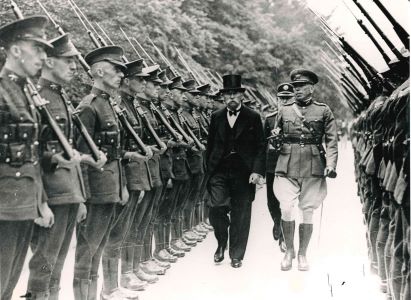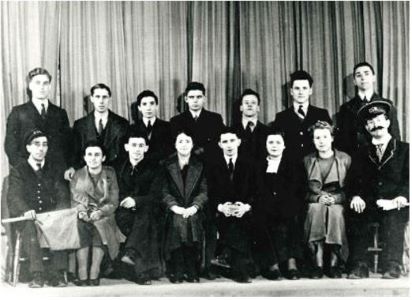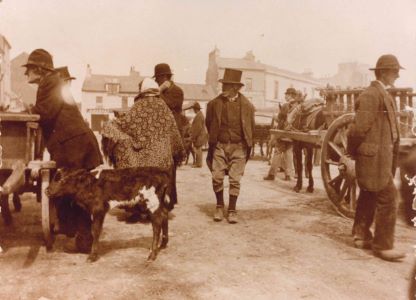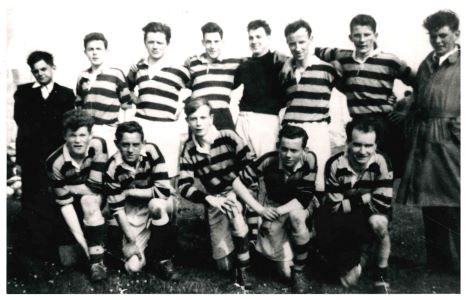Old Galway
THE DAY THE WAR CAME TO GALWAY

by Tom Kenny
On September 3rd, 1939 at 11am, many Galwegians listened to the British Prime Minister’s broadcast declaring war on Germany. Very early the following morning, the following dramatic radio message came through to the Harbour Office, “Norwegian Motor Vessel ‘Knute Nelson’ picked up 450 shipwrecked people, proceeding Galway. Due tomorrow morning, Tuesday 5th. Please arrange tender for landing same. Also notify pilot on Aran Islands. Please have medical supplies ready, From Master, September 4th”.
GALWAY’S FIRST FREEMAN

by Tom Kenny
On August 31st, 1939, Dr. Douglas Hyde, President of Ireland, signed his name in Irish in a small leather-bound book as the first Freeman of Galway.
He had travelled to the city the day before, stayed at the Eglinton Hotel and attended performances of some of his own plays in An Taidhbhearc. At 11am the following morning, he was driven in an open motor car through flag-bedecked streets to University College. The pavements along the route were lined with citizens and visitors from all parts of the country. He carried a bouquet of flowers which had been presented to him by seven year old Rita Curran from Salthill.
THE PENNY DINNERS

by Tom Kenny
The Penny Dinners Committee was a name given to a voluntary group who used to provide free dinners for 40 to 80 impoverished children four times per week in the late 1920's and early 1930’s. In fact the title was a misnomer, in no sense were they penny dinners. The children could not afford to give a penny for them nor could the committee provide a dinner for a penny. The funding for these meals came from the people of Galway and also from fundraising productions they put on, mostly in the Columban Hall.
THE CLADDAGH RING

by Tom Kenny
The story of the Claddagh Ring, which is made up of a plain hoop attached to a hammered or cast bezel designed as two hands clasping a crowned heart, has so much folklore and myth attached to it that it is hard to know where legend ends and truth begins. The motif of clasped hands is usually referred to as a ‘fede’ or ‘hands in faith’ ring and has been used on love rings since Roman times. The heart, regarded by lovers as the seal of affection, made an appearance on rings at a later date as did the crown which is the distinguishing feature of the Claddagh Ring from all the others.
A FAIR DAY IN EYRE SQUARE, c.1885

by Tom Kenny
Two hundred years ago, cattle fairs were held regularly at Fairhill in the Claddagh, then later in the century, they moved them over to Eyre Square where they often spilled over into adjoining streets like Williamsgate Street and Forster Street. They took place in the Square for a long time until they were moved to the Fairgreen.
AN GARDA SÍOCHÁNA, THE EARLY YEARS IN GALWAY

by Tom Kenny
After the truce, the R.I.C. handed over their barracks to the Irish Free State. One hundred years ago this month, the Government set up An Garda Síochána, an unarmed civic police force. Unfortunately, the first group of Gardaí who arrived in Galway by train had no barracks to go to, the Eglinton Street headquarters having been destroyed in an arson attack on the night of July 2nd, 1922. A search began for someplace to house the 23 Gardaí and that evening, they managed to find accommodation in The County Club. They stayed there for almost a year.
THE RIC IN GALWAY

by Tom Kenny
In the 18th century, attempts at maintaining Law and Order in Galway were poor. Occasional groups of civilian vigilantes were set up, but they were not very successful. Then, 200 years ago, in 1822, the Chief Secretary Henry Goulburn set up the Irish Constabulary. In 1824, Edward Blake from Mary Street became the first Catholic in Ireland to become a constable. In 1825, a decision was made to bring police to Galway. Some time later a barracks was set up in Abbeygate St., then one in Eyre Square (where Giblin’s Hotel was situated later) and one in Dominick St. where An Tobar Nua is today. The force gradually became very organized, were successful in dealing with crime and so Queen Victoria granted them the term ‘Royal’.
SOCCER IN SALTHILL

by Tom Kenny
The game of soccer in Salthill really began with Christy Gilbert. He formed a club in the early 1940’s called Salthill Crusaders and they played for several years with some success. Some of the players associated with the club were Harry Lupton, Donal Murray, Frank Lydon, Arthur Stephens, Brendan Collins, Tommy Stephens, Billy and Leo Shaw, Donie Kelleher.
